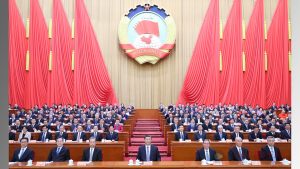
China Reacts to Sluggish July Data with Key Rate Cuts and Stimulus Measures
The Chinese economy faces heightened headwinds as a slew of lackluster data for July emerges, casting a shadow over its recovery trajectory. In response to these concerning indicators, Chinese authorities have executed a surprising move by cutting key policy rates in an effort to prop up economic activity.
Less than an hour before the scheduled release of a comprehensive batch of July data, China’s central bank made an unexpected decision to lower key policy rates for the second time in a mere three months. This dramatic step underscores the rapid decline of the post-COVID economic rebound, a development that has sent reverberations throughout global financial markets.
The National Bureau of Statistics (NBS) unveiled data on Tuesday revealing that industrial output expanded by a modest 3.7% year-on-year in July. This marks a notable slowdown from the 4.4% pace recorded in June. However, the July figure fell short of expectations, as a Reuters poll of analysts had projected a more robust 4.4% increase.
Retail sales, which serve as a pivotal gauge of consumer sentiment and economic consumption, inched up by a mere 2.5% in July. This growth rate represents a decline from June’s 3.1% surge and significantly missed analysts’ predictions of a more robust 4.5% expansion. This lackluster performance, despite the typically vibrant summer travel season, underscores the economic challenges at hand and marks the slowest growth rate since December 2022.
Julian Evans-Pritchard, an economist at Capital Economics, emphasized the overall disappointment, noting that “All the main activity indicators undershot consensus expectations in July, with most either stagnant or barely expanding in month-on-month terms.”
The dire situation in China’s property sector, with real estate giants like Country Garden grappling with financial turmoil, compounds the concerns. Experts warn that unless prompt policy support is implemented, the economy could be at risk of slipping into a recession.
The repercussions of these developments were felt on a global scale, as Asian stocks experienced declines, and the dollar remained resilient against weaker Chinese data and the latest policy easing measures. As a direct response to the rate cuts, prominent state-owned Chinese banks were observed selling U.S. dollars and purchasing yuan, a move aimed at stabilizing the nation’s currency.
Sovereign bond yields reached three-year lows, while benchmark stock indexes displayed marginal weakness. This latter phenomenon could be attributed to market anticipation of forthcoming stimulus measures.
Despite authorities unveiling stimulus initiatives in the previous month, ranging from incentivizing auto and home appliances consumption to relaxing certain property regulations and pledging support to the private sector, the sustained struggles within the property sector, coupled with mounting local government debt and elevated youth unemployment rates, continue to hinder a sustainable economic resurgence.
The urgency for additional stimulus is further underscored by recent figures. Bruce Pang, Chief Economist at Jones Lang Lasalle, remarked, “Today’s data shows how difficult it is for China’s economy to sail against the wind, with challenges from almost all dimensions and efficient policy support from few fronts.”
Further data revealed that fixed asset investment expanded by a modest 3.4% during the first seven months of 2023 in comparison to the corresponding period of the previous year. This growth rate fell short of the projected 3.8% rise and represented a slowdown from the 3.8% expansion observed during the January-June period.
Investment within the property sector has notably declined, shrinking by 8.5% year-on-year from January to July. This marks the 17th consecutive month of contraction, highlighting the persistent weakness in the sector.
The waning demand for the property sector, once a primary driver of economic growth, has raised alarms. To address this issue, the Politburo, a high-ranking decision-making body of the Communist Party, emphasized the need to adapt property policies in response to significant shifts in market supply and demand.
The national survey-based jobless rate inched up slightly from 5.2% in June to 5.3% in July. This modest increase follows a record-high youth jobless rate of 21.3% in June.
In a significant move, the NBS spokesperson Fu Linghui announced during a press conference on Tuesday that the bureau will suspend the publication of survey-based jobless rates for individuals aged 16 to 24 from August onwards. Fu highlighted China’s commitment to enhancing employment statistics and adapting to evolving market dynamics.
Amidst the complex web of economic challenges, Chinese policymakers find themselves at a critical juncture, grappling with the need for targeted stimulus measures to reignite growth and steer the economy towards a sustainable recovery path.
Acknowledgment: This Report was Enriched with Insights from a Reuters Article
















Comments